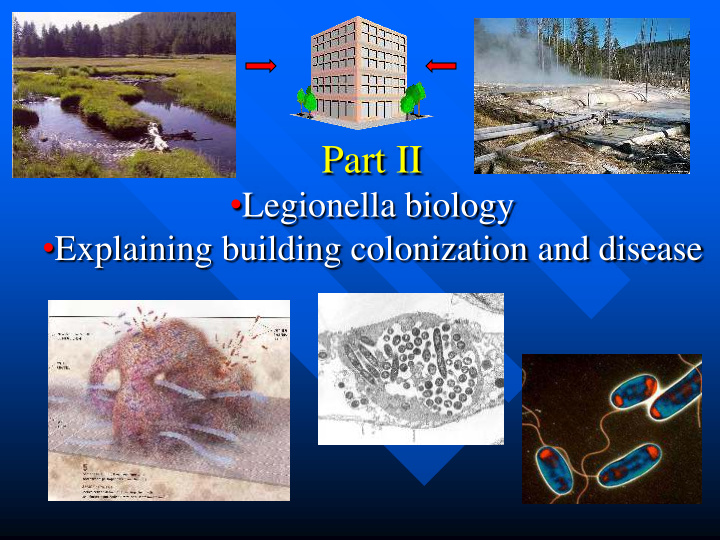



Part II • Legionella biology • Explaining building colonization and disease
Legionella are a Family of Environmental Bacteria that Live in Water Family of different species • > 50 different species in genus Legionella • Only half have been associated with disease • L. pneumophila – 90% of disease
Legionella are a Family of Environmental Bacteria that Live in Water Family of different species • > 50 different species in genus Legionella • Only half have been associated with disease • L. pneumophila – 90% of disease Legionella 10% 90% Other species – only in environment L. longbeachae L. pneumophila L. bozemanii L. micdadei 14 serogroups L. dumoffii 5% L. feeleii 85% L. wadsworthii Serogroup 1 (sg1) Serogroups 2-14 L. anisa others Sub-typing, molecular fingerprinting – outbreak investigations
Legionella are Environmental Bacteria that Live in Water Surface water (lakes, streams, etc) • Virtually all have Legionella • Low numbers - rare disease Actually, Legionella live in a vacuole inside of amoebae and other protozoa that live in the water In the human lung Legionella grow in amoebae-like phagocytic cells called macrophages
Legionella - Habitat Intracellular growth- amoebae and other protozoa • protects Legionella from drying during aerosolization • One inhaled amoeba could provide an infectious dose Some protozoa spit out these vacuoles full of Legionella
Legionella Live in Warm Water Surface water (lakes, streams, etc) • Virtually all have Legionella • Low numbers - rare disease Thermal areas (i.e. near hot springs) • Elevated numbers – rare disease 6
Legionella Live in Building Water Building water – requirements to be met for Legionnaires disease • warm (not too cold, not too hot) • high levels of Legionella • mechanism for airborne (aerosol) dissemination • susceptible host (hospitalized, older, smokers, etc.)
Legionella Live in Water Biofilms
Legionella Live in Water Biofilms Includes escaping amoebae and vacuoles (pellets) full of Legionella Legionella In nature there may be hundreds of different bacteria Sharon G. Berk, Gary Faulkner, Elizabeth Garduño, Mark C. Joy, Marco A. Ortiz-Jimenez, 3 and Rafael A. Garduño. Appl Environ Microbiol. 74: 2187 (2008) Includes amoebae feeding on these bacteria Mature biofilm
City water (in low numbers) aerosols
City water (in low numbers) aerosols Hospital drinking/aspiration from URT Hospital-acquired LD (HA-LD) -or- Healthcare-associated LD Many different Legionella species and serogroups
aerosols Other buildings Community-acquired LD (CA-LD) Amost entirely L. pneumophila serogroup 1
Legionella amplification in building water Potable water (hot water) Cooling towers After entering from the city water in low numbers Decorative fountains / Water walls Whirlpool spas
Legionella amplification in building water Potable water (hot water) Cooling towers Decorative fountains / Water walls Whirlpool spas
Legionella amplification in building water Unusual sources Vegetable misters Ultrasonic humidifiers Louisiana – 32 cases/2 deaths (1990) Sweden – 8 cases/2 deaths (2008) Wales (hotel) – 5 cases, 2 deaths (2000) Cyprus (hospital) – 11 infant cases, 2 deaths (1999) New York – 2 cases (2007) Car/bus wash Australia – 5 cases (2008)
Most cases are single isolated events aerosols Sources unknown or unconfirmed Susceptible person - wrong place at the wrong time
Disease Pathogenesis Legionnaires’ Disease – acute pneumonia Inhalation of infectious particles into the lung Incubation period of 2-14 days before symptoms
Disease Legionnaires’ Disease – acute pneumonia Inhalation of infectious particles into the lung Engulfment by alveolar macrophages, monocytes Rapid intracellular replication (thinks its an amoeba!) Acute inflammation- fluid accumulation, white cells Respiratory failure Resident alveolar macrophages phagocytic cells – amoeba-like
Replication in macrophages over 24hr
Legionnaires’ Disease - Diagnosis Clinical presentation – not specific Chest X-ray – not specific
Legionnaires’ Disease Diagnosis Clinical presentation – not specific Chest X-ray – not specific Sputum- traditional laboratory tests - negative Lack of response to antibiotics such as penicillin ↓ Atypical Pneumonia ↓ Legionella laboratory tests – specific diagnosis !! May be 2-3 days post-admission
Legionnaires Disease - Diagnosis Sputum, bronchial aspirate, lung biopsy (autopsy) • Culture (special media) – several days • Low sensitivity, have an organism to characterize 5-7 days Suspect colonies transferred to CYE agar with and without L-cysteine Legionella Species/serogroup antisera e.g . L.pneumophila sg1 CYE agar (selective and non-selective) Sub-typing, molecular typing With and without acid-treatment
Legionnaires Disease - Diagnosis Sputum, bronchial aspirate, lung biopsy (autopsy) • Culture (special media) – several days • Low sensitivity, have an organism to characterize Patient A Compare via sub-typing and molecular typing ? Environmental Clinical isolate isolates CYE agar (selective and non-selective) With and without acid-treatment Patient B
Legionnaires Disease - Diagnosis Urine antigen test - same day Results within an hour • High sensitivity/specificity Pieces of Legionella (antigens) in the blood get filtered out into the urine
Legionnaires Disease - Diagnosis Urine antigen test - same day Results within an hour • High sensitivity/specificity Only detects L. pneumophila sg 1 Will not detect all hospital-acquired Legionnaires’ disease
Treatment Resistant to penicillins and cephalosporins! Classical treatment: erythromycin or newer macrolides such as azithromycin, clarithromycin New- better survival with fluoroquinolones. In severe cases use both a macrolide and quinolone Patients still die (5-30%) due to delay in diagnosis along with the rapid progression of the disease, particularly in immunocompromised patients.
Recommend
More recommend